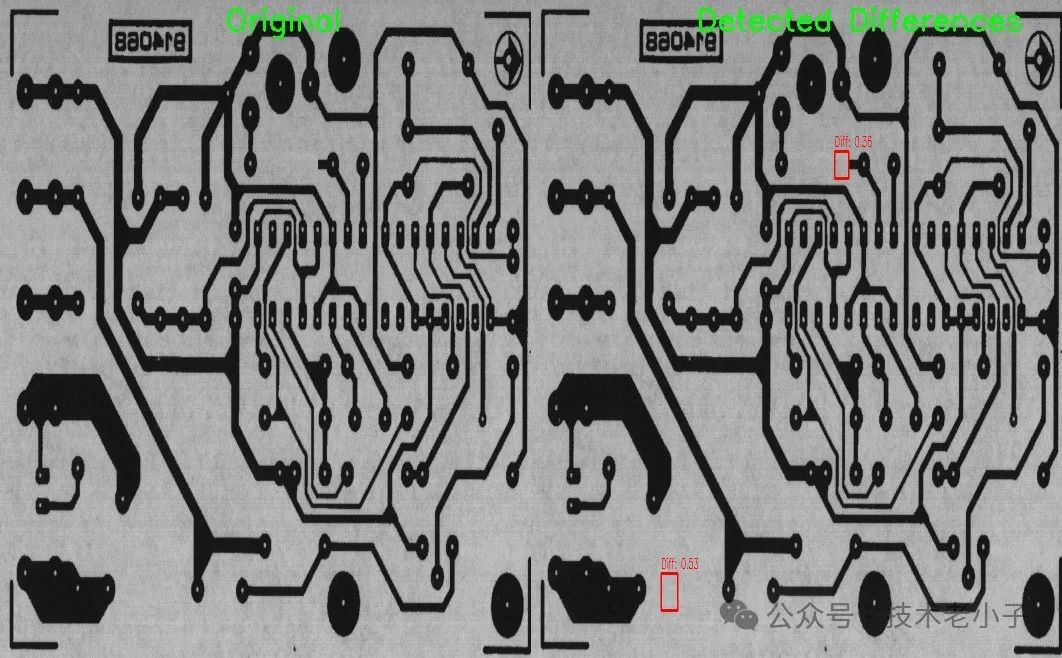本文将详细介绍如何使用OpenCvSharp来实现模板图像与待检测图像之间的差异检测。这种技术常用于产品质量检测、PCB板检测等场景。上面的示意图展示了一个简单的例子,左边是完整的模板图像,右边是缺少部分元件的待检测图像。
环境准备
// 需要安装的NuGet包
// Install-Package OpenCvSharp4
// Install-Package OpenCvSharp4.runtime.win
using OpenCvSharp;
using System;
using System.Collections.Generic;完整代码实现
using OpenCvSharp;
using System;
using System.Collections.Generic;
using System.Linq;
using System.Text;
using System.Threading.Tasks;
namespace OpenCv082902
{
public class TemplateDifferenceDetector
{
/// <summary>
/// 检测结果类
/// </summary>
public class DetectionResult
{
public Point Location { get; set; }
public double Difference { get; set; }
public Rect Region { get; set; }
}
/// <summary>
/// PCB图像差异检测的配置参数
/// </summary>
public class DetectionConfig
{
public double Threshold { get; set; } = 0.5; // 差异阈值
public double MinArea { get; set; } = 10; // 最小检测面积
public int BlurSize { get; set; } = 3; // 高斯模糊核大小
public int MorphSize { get; set; } = 3; // 形态学操作核大小
public bool EnableHistEqualization { get; set; } = true; // 是否启用直方图均衡化
public bool EnableNoiseReduction { get; set; } = true; // 是否启用降噪
}
/// <summary>
/// 执行差异检测
/// </summary>
/// <param name="templatePath">模板图像路径</param>
/// <param name="targetPath">待检测图像路径</param>
/// <param name="config">检测配置参数</param>
/// <returns>检测结果列表</returns>
public static List<DetectionResult> DetectDifferences(
string templatePath,
string targetPath,
DetectionConfig config = null)
{
config ??= new DetectionConfig();
// 读取图像
using var template = Cv2.ImRead(templatePath);
using var target = Cv2.ImRead(targetPath);
// 确保图像成功加载
if (template.Empty() || target.Empty())
{
throw new Exception("无法加载图像");
}
// 预处理图像
using var processedTemplate = PreprocessImage(template, config);
using var processedTarget = PreprocessImage(target, config);
// 计算差异图
using var diff = new Mat();
Cv2.Absdiff(processedTemplate, processedTarget, diff);
// 应用阈值处理
using var thresholdMat = new Mat();
Cv2.Threshold(diff, thresholdMat, config.Threshold * 255, 255, ThresholdTypes.Binary);
// 应用形态学操作来减少噪声
if (config.EnableNoiseReduction)
{
var kernel = Cv2.GetStructuringElement(
MorphShapes.Rect,
new Size(config.MorphSize, config.MorphSize)
);
Cv2.MorphologyEx(
thresholdMat,
thresholdMat,
MorphTypes.Open,
kernel
);
}
// 寻找轮廓
Cv2.FindContours(
thresholdMat,
out Point[][] contours,
out HierarchyIndex[] hierarchy,
RetrievalModes.External,
ContourApproximationModes.ApproxSimple
);
// 分析差异区域
var results = new List<DetectionResult>();
foreach (var contour in contours)
{
// 计算轮廓面积,过滤掉太小的区域
double area = Cv2.ContourArea(contour);
if (area < config.MinArea)
continue;
// 获取边界矩形
var boundingRect = Cv2.BoundingRect(contour);
// 计算该区域的平均差异值
using var roi = new Mat(diff, boundingRect);
Scalar meanDiff = Cv2.Mean(roi);
results.Add(new DetectionResult
{
Location = new Point(boundingRect.X, boundingRect.Y),
Difference = meanDiff.Val0 / 255.0, // 归一化差异值
Region = boundingRect
});
}
return results;
}
/// <summary>
/// 图像预处理
/// </summary>
private static Mat PreprocessImage(Mat input, DetectionConfig config)
{
// 转换为灰度图
var processed = input.CvtColor(ColorConversionCodes.BGR2GRAY);
// 应用高斯模糊减少噪声
if (config.EnableNoiseReduction)
{
Cv2.GaussianBlur(
processed,
processed,
new Size(config.BlurSize, config.BlurSize),
0
);
}
// 直方图均衡化增强对比度
if (config.EnableHistEqualization)
{
Cv2.EqualizeHist(processed, processed);
}
return processed;
}
/// <summary>
/// 可视化检测结果
/// </summary>
public static void VisualizeResults(
string templatePath,
string targetPath,
string outputPath,
List<DetectionResult> results)
{
using var target = Cv2.ImRead(targetPath);
using var output = target.Clone();
// 在图像上标注差异区域
foreach (var result in results)
{
// 绘制矩形框
Cv2.Rectangle(
output,
result.Region,
new Scalar(0, 0, 255), // 红色
2
);
// 添加差异值标注
string text = $"Diff: {result.Difference:F2}";
Cv2.PutText(
output,
text,
new Point(result.Location.X, result.Location.Y - 5),
HersheyFonts.HersheySimplex,
0.5,
new Scalar(0, 0, 255),
1
);
}
// 创建对比图
using var comparison = new Mat();
using var targetResized = target.Resize(new Size(target.Width / 2, target.Height));
using var outputResized = output.Resize(new Size(output.Width / 2, output.Height));
Cv2.HConcat(new[] { targetResized, outputResized }, comparison);
// 添加标题
Cv2.PutText(
comparison,
"Original",
new Point(target.Width / 4 - 40, 30),
HersheyFonts.HersheySimplex,
1,
new Scalar(0, 255, 0),
2
);
Cv2.PutText(
comparison,
"Detected Differences",
new Point(target.Width * 3 / 4 - 100, 30),
HersheyFonts.HersheySimplex,
1,
new Scalar(0, 255, 0),
2
);
// 保存结果图像
comparison.SaveImage(outputPath);
}
/// <summary>
/// 使用示例
/// </summary>
public static void Example()
{
var config = new DetectionConfig
{
Threshold = 0.3, // 降低阈值使检测更敏感
MinArea = 5, // 降低最小面积阈值
BlurSize = 3, // 适当的模糊核大小
MorphSize = 2, // 较小的形态学操作核心
EnableHistEqualization = true,
EnableNoiseReduction = true
};
var results = DetectDifferences(
"template.jpg",
"target.jpg",
config
);
VisualizeResults(
"template.jpg",
"target.jpg",
"output.jpg",
results
);
Console.WriteLine($"Found {results.Count} differences");
foreach (var result in results)
{
Console.WriteLine($"Difference at ({result.Location.X}, {result.Location.Y}) " +
$"with difference value: {result.Difference:F2}");
}
}
}
}使用示例
using OpenCv082902;
using OpenCvSharp;
using System;
using System.Collections.Generic;
class Program
{
static void Main(string[] args)
{
// 使用自定义配置
var config = new TemplateDifferenceDetector.DetectionConfig
{
Threshold = 0.3,
MinArea = 5,
BlurSize = 3,
MorphSize = 2,
EnableHistEqualization = true,
EnableNoiseReduction = true
};
var results = TemplateDifferenceDetector.DetectDifferences("pcb_layout.png", "pcb_layout1.jpg", config);
// 可视化结果
TemplateDifferenceDetector.VisualizeResults("pcb_layout.png", "pcb_layout1.jpg", "output.jpg", results);
Console.ReadKey();
}
} 图片
图片
检测失败的可能原因:
- 图像对齐问题 - 两张图像可能有微小的偏移或旋转
- 阈值设置过高 - 导致小的差异被忽略
- 最小面积设置过大 - 导致小的差异区域被过滤
- 图像质量问题 - 如噪声、模糊等影响检测效果
总结
本文详细介绍了使用OpenCvSharp实现模板差异检测的完整方案。通过合适的图像处理和计算机视觉技术,可以有效地检测出两张图像之间的差异。代码实现了基本功能,并提供了良好的扩展性。在实际应用中,可以根据具体需求调整参数和添加其他功能。























